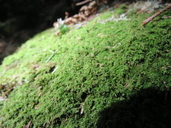- Map Distribution
- Description
- eFlora Distribution
- Illustrations
- Cal Photos images
- Elevation by latitude plot
MAP CONTROLS
1. You can change the display of the base map and layers by clicking on the layer control box in the upper right-hand corner.
2. California county polygons can be turned off and on in the layer control box.
3. Filling of Jepson subdivision polygons can be turned off and on in the layer control box.
Database links
UC Specimens in the University and Jepson Herbaria Public Portal
Specimens of Heterocladium macounii in the Consortium of North American Bryophyte Herbaria portal (CNABH)
Heterocladium macounii, Bull. Torr. Bot. Club 28: 127. 1901. -- Heterocladium heteropteroides Best, Bull. Torr. Bot. Club 28: 128. 1901.
Plants to 6 cm long in intricate, irregularly to pinnately branched in deep green to yellow green mats. Stems and branches little differentiated, somewhat to strongly attenuate at apices. Leaves to 1 mm long, 1.5–2: 1, ovate, broadest immediately above the base and gradually tapered to the narrow acumen. Leaves when moist erect and overlapping with the apices rigidly erect, not catenulate, somewhat longitudinally conduplicate and homomallously downwardly directed when dry. Margins plane, crenulate throughout. Median cells rhomboidal with the walls evenly thickened throughout, to 8 µm wide, 1.2–1.8: 1, with 2–4 papillae on each surface and with the papillar salients up to 2 µm high. Juxtacostal cells, especially the basal, elongate, pluripapillose to smooth. Marginal cells isodiametric, mostly unipapillose, decurrent from leaf insertion in a strip only one cell wide for up to six cells in length. Apical cell typically short, often isodiametric. Alar cells not differentiated. Costa broad at base but rapidly tapered and ending near the leaf middle. Axillary hairs not offset from leaf insertion, to 40 µm long, 2–3 celled, with no basal brown cells. Paraphyllia reduced to closely spaced papillae on the stem. Pseudoparaphyllia arched over bud, narrowly triangular to lanceolate, serrate, usually papillose.
Dioicous with male plants somewhat smaller than the females. Perichaetia on main stems with bracts erect and somewhat longer than vegetative leaves. Seta brown to deep red brown, smooth, to 1.5 cm long. Urn red brown, strongly inclined, oblong and asymmetric, to 2: 1, to 1 mm long, somewhat strangulate when dry. Operculum rostrate, about as long as urn. Exothecial cells short rectangular, 1.5–3.0: 1, to 25 µm wide, rather thick walled with strong corner thickenings. Stomates superficial, at base of urn. Annulus well differentiated, not revoluble. Exostome to 400 µm long, red-brown, horizontally striate at base, papillose to nearly smooth distally. Endostome almost as long as exostome, with basal membrane comprising about 1/2. Endostome processes lightly papillose, keeled and perforate, with 2–3 cilia. Spores smooth, to 10 µm in diameter.
The wiry and branching plants of Heterocladium macounii form densely interwoven and thick cushions which may seem to bear slight resemblance to the turfs of Bryolawtonia vancouveriensis, or to Claopodium bolanderi or C. crispifolium. The blunt leaves of Bryolawtonia easily distinguishes that plant; while the two species of Claopodium are easily distinguished because of their catenulate leaves with hyaline awns.
Schofield (1985) presents an exhaustive treatment of this single species. Heterocladium macounii is restricted in California to the extreme northwestern corner of the state, including Humboldt and Del Norte Counties. Elsewhere, it is a coastal plant of western North America, extending from southern Alaska to California. Outlying populations in the southern Appalachians (North Carolina and Tennessee) and in central Mexico are stated by Schofield (1985) to be conspecific with our western North American materials.
Schofield (1985) emphasizes the growth of this plant in quite shaded and moist sites on tree bases and on rocks. This is an accurate description of the ecology of the species in California except that we have not yet found it as an epiphyte
Vouchers: Del Norte Co.: Smith River along Highway 199, Jedediah Smith Redwood State Park, Norris 68934; Humboldt Co.: near Prairie Creek Campground, Prairie Creek Redwood State Park, Norris 12030 and Highway 299 at mile 9.4 east of Arcata, Norris 55074; Trinity Co.: Onion Lake Road about 7 miles south of Onion Lake, Norris 72549 & 72562.
Literature: Bourell 1981. As Heterocladium heteropteroides Koch 1950a.
Geographic subdivisions for Heterocladium macounii: NW. |
Illustration References: Malcolm et al. 2009 p. 292; Lawton 1971; Sharp et al. 1994.









